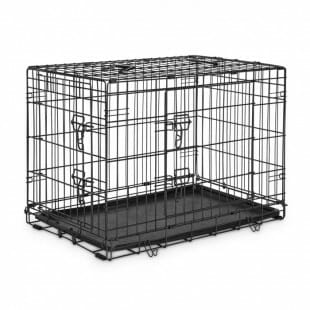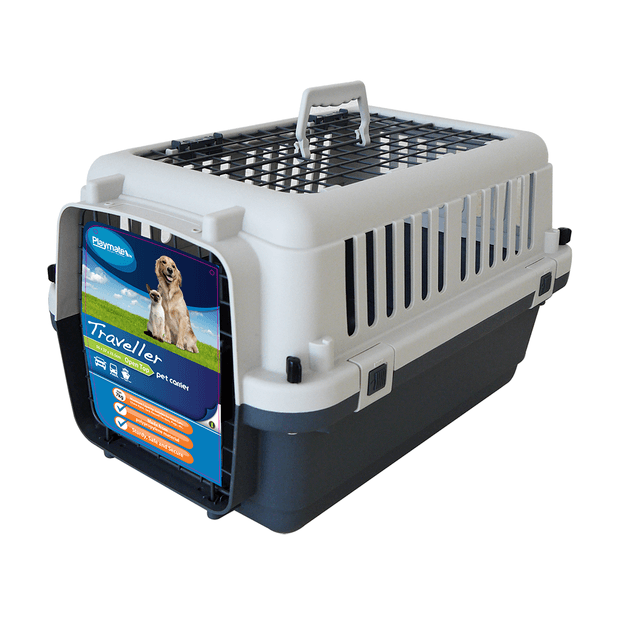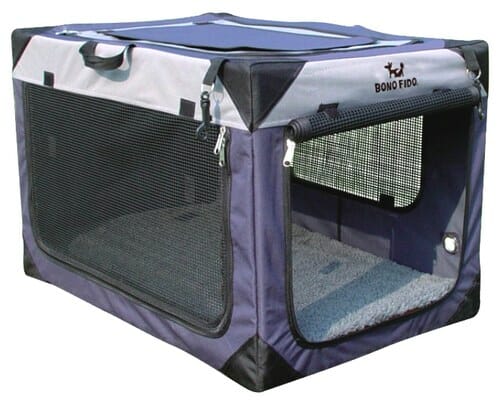We’re so happy you made the commitment to become a new puppy parent! It’s expected that you’ll face challenges in the coming weeks as a first-time whelp owner, but we’re here to help make the process as easy and enjoyable as possible. Before everything else, start off by finding out how to prepare your home and which tools you need before your new pet comes home. Aside from this, it’s good to learn what to expect during his first year with you.
In this puppy crate training guide, we’ll teach you everything you need to know about crate training your puppy. We’ll cover the following:
- What is crate training?
- What are the benefits of crate training?
- When can I start crate training my puppy?
- How do I pick the right crate?
- How do I crate train my puppy?
- How long can I leave my puppy in a crate?
- When and how can I wean him from the crate?
- Other crate training reminders
What is crate training?
Wikipedia defines crate training as “the process of teaching a pet to accept a dog crate or cage as a familiar and safe location.” Dogs have an innate denning instinct that makes them seek out protected, den-like spaces. These private sanctuaries give them a chance to rest, recuperate, nap, or hide.
What are the benefits of crate training?
Though staying in a crate may take some getting used to, your puppy will truly benefit from having an area to call his own. Crate training can help with various aspects of puppy parenthood such as housetraining your puppy, limiting your puppy’s access at home, containing him for transport or when there are guests, and keeping him safe when you’re not around or when everyone’s asleep. A crate can make your pet feel protected, especially from loud noises, and even after if he ever undergoes a surgery.
When can I start crate training my puppy?
Crate training can begin as soon as you take your eight-week-old puppy home from the animal shelter or foster home. If you get a pup earlier than that, you can gradually introduce the crate to him when he is between five to seven weeks old.
How do I pick the right crate?
When selecting the right crate for your puppy, you must consider the size and the material of the crate. A good crate size would be something your pooch can comfortably stand up, turn around, and lie down in with legs outstretched. Don’t buy a crate that’s too big for him, or he might end up soiling one side of it.
As for the material, you can choose from crates made out of metal, plastic, or fabric. Metal crates are popular for their sturdiness, visibility, and ventilation, while plastic crates are popular for their lightness and portability. Fabric crates are usually collapsible, but they’re not as durable as their metal or plastic counterparts. If you expect your puppy to grow taller or wider over the next few months, you can invest in a metal crate with removable partitions that you can adjust as he increases in size.

Metal crate from Petbarn

Plastic crate from Pet Circle

Fabric crate from My Pet Warehouse
How do I crate train my puppy?
Crate training is a process that should be introduced to your dog in a positive way. It can take your puppy a while to master using a crate based on his age, temperament, and past experiences, so you’ll need to practise patience and be consistent in your training.
Teach your puppy how to use the crate through these steps:
1 Introduce a puppy to his crate.
Start off by placing the crate inside a quiet room with few distractions. Wait for him to approach and investigate the crate. If he chooses to ignore it, you can make the crate more enticing for him by adding cosy bedding and tossing in his favourite toy or puppy treats. Do not lock him up in the crate or leave him alone during his first crate experience. After he sniffs and explores the crate, reward him with a treat. This way, he’ll view the crate in a positive light.
2 Prepare your puppy for crate time.
Before putting him inside a crate, let your puppy relieve himself and get rid of some of his energy through play or exercise. This way, he will be relaxed and more inclined to use the crate.
3 Start crate training for short periods of time.
With the door left open, urge your puppy to go inside the crate with his toy or puzzle for 15 seconds. If your puppy doesn’t want to enter his crate, you can pick him up gently and place him inside. After that duration, call him out to join you and reward him with positive words, gentle pats on the head, and/or treats for five seconds. Remove his toy or puzzle while he is outside the crate. Repeat the first step after 10 seconds, gradually extending the time from seconds to minutes but never leaving his side.
After a few successful tries, repeat the process but close the door once he gets distracted by his toy or puzzle. You know you’re doing it right if he stays calm and entertained despite being locked inside the crate. Try to leave the door closed for five minutes. If he shows signs of anxiousness (such as pacing, whining, or barking), readjust the amount of treats in the puzzle or the length of time he stays inside the crate with the door closed.
4 Feed him inside his crate.
Let your dog get used to his crate by initially placing his bowl in the crate with the door open. If he’s scared of entering his crate, you can start by placing his food bowl just outside it. Place it by the door, then slowly move it in further to the end for each subsequent meal. When he gets used to eating inside his crate, close the door during mealtimes. Open it as soon as he’s done eating, then gradually leave it closed for longer periods each time.
5 Increase your distance and his stay inside the crate.
As you gradually lengthen the amount of time your puppy stays inside the closed crate, you can also try leaving the room and observing his reactions. Start with 15 to 30 seconds, and make your way up to five minutes. Gradually increase the intervals by five or 10 minutes, until you reach the 30-minute mark. Eventually remove his toy or puzzle, so he gets used to staying inside his crate without it.
6 Create a consistent crate training schedule.
Provide a regular crate routine for your puppy so that he learns through repetition. Let him have a potty break every time he leaves his crate, so he remembers not to soil his crate.
In the evenings, feed him three to four hours before bedtime to lessen the chances of him pooping in the middle of the night. Lessen his water intake before bedtime, and remove his water bowl from his crate (unless he has a medical condition that requires drinking water throughout the night). Also, craft a bedtime routine that consists of relaxing physical and mental activities. Nothing that would overstimulate your puppy.
Remember that your puppy’s bladder is small, so he would still need to pee during the night. Start off by planning for two to three nighttime potty breaks and taking note of his schedule, so you can anticipate the times he must go outside. If your puppy wakes up in the middle of the night, he most likely needs to alleviate himself.
How long can I leave my puppy in a crate?
The Humane Society states that puppies under 26 weeks (6 months) should not stay in a crate for more than 3 to 4 hours at a time. Preventive Vet breaks down the whelp’s age and the maximum time he can stay in a crate:
9 to 10 weeks old – 30 minutes to 1 hour
11 to 14 weeks old – 1 to 3 hours
15 to 16 weeks old – 3 to 4 hours
17 weeks old and above – 4 to 6 hours
When and how can I wean him from the crate?
Certified dog trainer Sue Brown, who is also the co-founder and co-owner of The Light of Dog, shares that crates should be “temporary tools that we wean our dogs off from once they are well-behaved in the house when unsupervised.”
If you feel confident enough for your puppy to be let loose inside your home, begin by letting him roam around a small area for about 5 minutes. Confine him in a safe, puppy-proofed space and close the doors to your bedroom, bathroom, and laundry room. Check back to see if he did anything naughty while you were away, such as gnawing on furniture or peeing on the floor. When he proves to be a good boy, progressively increase the duration of his time inside the house and the areas he can access.
It’s best not to rush the weaning process to avoid confusing your pet. Rushing the weaning process would cause your dog to commit mistakes, or worse, regress in his potty training.
Other crate training reminders
Never use the crate as a form of punishment for your puppy, and never leave him in the crate all day. Before placing your puppy in a crate, remove his collar, harness, or anything else that might get caught in his crate and cause an accident.
Put the crate in a comfortable place that doesn’t get too hot or cold, and away from items (such as power cables or toxic plants) that he could play with. In the day, you can place the crate in the living room or kitchen—right where the action is so he can feel close to you despite being in his crate. At night, you can transfer the kennel to your bedroom or near it so you can monitor your puppy throughout the night.
In conclusion
You need to be consistent and patient to successfully teach your puppy how to use his crate. Shower him with praise, pats, and treats every time he uses the crate correctly, so he associates it with positive memories. Most importantly, don’t rush his training. It may take him days, weeks, or even months to feel completely comfortable using his crate.
Click here to discover more puppy-related guides from Waldo’s Friends.
Leave a comment
Your email address will not be published. All fields are required.